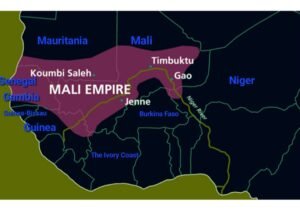1. Timeline Challenge
Chronological order:
1. c) Sundiata’s exile – early 13th century (≈ 1230 CE)
2. a) Battle of Kirina – 1235 CE, where Sundiata defeats Souma Beré
3. b) Mansa Musa’s pilgrimage to Mecca – 1324–1325 CE
4. d) Loss of Timbuktu to the Tuareg – late 15th century (≈ 1493 CE)
—
2. Map Activity
Instruction: On a blank map of Africa, shade the modern states that fell within the Mali Empire at its zenith (mid‑14th century).

—
3. Short Answer
Mansa Musa’s 1324‑25 pilgrimage flooded the Egyptian market with gold he distributed as gifts and alms. The sudden influx of high‑quality West African gold increased the supply of bullion, which depressed the price of gold relative to silver and boosted Egypt’s trade surplus with the Mediterranean. Egyptian merchants also benefited from the prestige and diplomatic ties forged during the pilgrimage, leading to a surge in commercial traffic through Cairo and Alexandria.
—
4. Creative Writing – Diary Entry
12 Rabiʿ al‑Awwal, 727 AH (June 1325 CE)
Today I set foot in the famed city of Timbuktu, its mud‑brick walls glowing under the Sahel sun. The air is thick with the scent of ink and parchment; scholars from far‑off lands—Berbers, Arabs, even a few from Andalusia—crowd the great Sankore courtyard.
Mansa Musa’s name is whispered in every lecture hall. He arrived a year ago, a caravan of camels bearing gold, ivory, and a retinue of envoys. The court has been transformed: new libraries, a school for the Qur’an, and a modest madrasah where I, a humble student from Gao, may study astronomy and mathematics.
The most astonishing sight is the golden procession that passed the city last month: the king, robed in a flowing white kaftan, his beard braided with pearls, handing alms to the poor and gifting gold to the Egyptian merchants at the port of Alexandria. The wealth he spreads seems endless, yet he spends it with a purpose—to earn the favor of Allah and to bring scholars like me to his realm.
I have begun copying a treatise on Ptolemaic astronomy. The teachers say that with the king’s patronage, our knowledge will travel farther than any caravan. I feel both humbled and hopeful, for in this city the pursuit of learning is as prized as the gold that once filled the king’s coffers.
— Aïssa, apprentice scribe, Timbuktu
…
☆
– 12 Rabiʿ al‑Awwal 727 AH is a date
– 12 – the 12th day of the month.
– Rabiʿ al‑Awwal – the 3rd month of the Islamic (Hijri) lunar calendar.
– 727 AH – the year 727 after the Hijra (the Prophet Muhammad’s migration in 622 CE).
– Gregorian equivalent – roughly 23 May 1327 CE (conversion may vary by one day depending on moon‑sighting).
– Relevance to Mansa Musa – falls a few years after his famous hajj (1324‑1325 CE) and would be used in chronicles to date events such as letters, battles, or religious observances during the later part of his reign (c. 1312‑1337‑1337 CE).
—
5. Discussion Prompt
Religious tolerance allowed the Mali Empire to integrate diverse peoples—animist Mandinka, Muslim Berbers, and Christian traders—without provoking rebellion. By permitting the free practice of Islam while respecting local customs, the state secured the loyalty of merchant communities that controlled the trans‑Saharan trade routes. This openness also attracted scholars and artisans, enriching the cultural and economic life of the empire. In a region where trade depended on the confidence of distant partners, a reputation for tolerance fostered stability and sustained prosperity.
